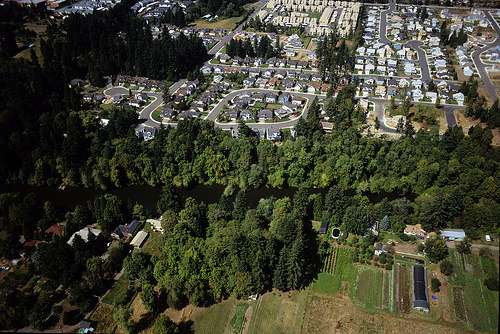Land policy changes would sequester more carbon and conserve habitat

Rewarding landowners for converting farmland into forest will be key to sequestering carbon and providing wildlife habitat, according to a new study by Oregon State University and collaborators.
Current land-use trends in the United States will significantly increase urban land development by mid-century, along with a greater than 10 percent reduction in habitat of nearly 50 at-risk species, including amphibians, large predators and birds, said David Lewis, co-author of the study and an environmental economist in OSU's College of Agricultural Sciences.
"One of the great challenges of our time is providing food, timber and housing, while also preserving the environment," said Lewis. "Our simulations show our growing appetite for resources could have cascading effects on wildlife and other vital services provided by nature."
"Policymakers have tools to increase tree cover and limit urban sprawl, such as targeted taxes, incentives and zoning," he added.
Paying landowners $100 an acre per year to convert land into forest would increase forestland by an estimated 14 percent and carbon storage by 8 percent by mid-century, the researchers say. Timber production would increase by nearly 20 percent and some key wildlife species would gain at least 10 percent more habitat, they added.
Yet this subsidy program would also shrink food production by 10 percent and comes with an annual $7.5 billion price tag, said Lewis.
Another policy option – charging landowners $100 per acre of land that is deforested for urban development, cropland or pasture – would generate $1.8 billion a year in revenue. More than 30 percent of vital species would gain habitat. Yet carbon storage and food production would shrink slightly, according to the study.
"Price drives how most landowners decide what to do with their property," Lewis said. "Some choices have market values – such as selling food and timber – and yet others, like sequestering carbon, do not earn money for landowners, who then have less incentive to provide them."
"To reverse loss of habitat and boost carbon storage, the government could provide compensation for services the free market does not currently offer," added Lewis.
However, researchers found neither the tax nor subsidy plan would limit the growth of urban sprawl. Instead, they simulated a prohibition on new urban development – such as building new housing and commercial properties – in rural and non-metropolitan areas.
By 2051, the policy would decrease urban growth by 24 percent in the researchers' simulation, but it would result in smaller gains in habitat and carbon storage than the tax and subsidy.
"There are inherent tradeoffs involved in any policy," Lewis pointed out. "More urban land comes at the expense of wildlife habitat, and more carbon storage could reduce food production. Understanding these choices can help us prepare for the different shapes our landscapes may take in the future."
More information: Joshua J. Lawler, David J. Lewis, Erik Nelson, Andrew J. Plantinga, Stephen Polasky, John C. Withey, David P. Helmers, Sebastián Martinuzzi, Derric Pennington, and Volker C. Radeloff. "Projected land-use change impacts on ecosystem services in the United States." PNAS 2014 111 (20) 7492-7497; published ahead of print May 5, 2014, DOI: 10.1073/pnas.1405557111
Journal information: Proceedings of the National Academy of Sciences
Provided by Oregon State University


















